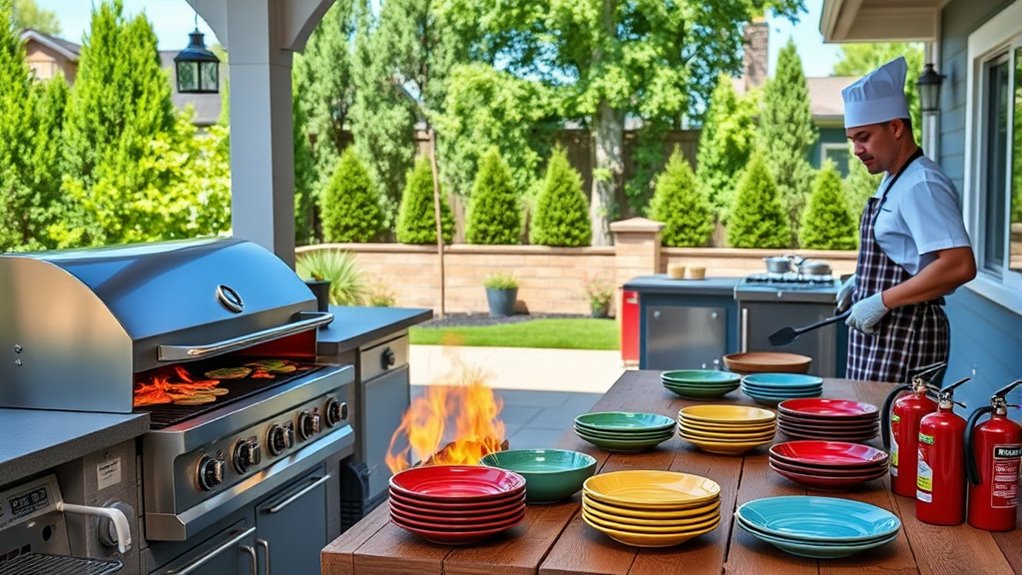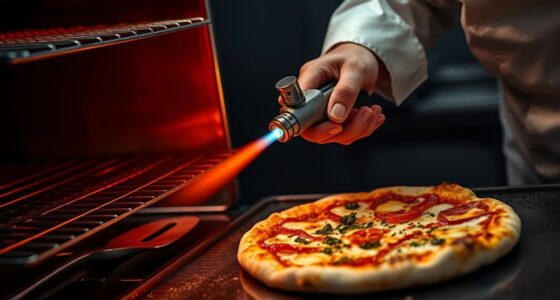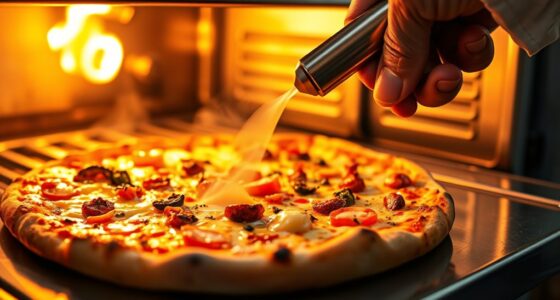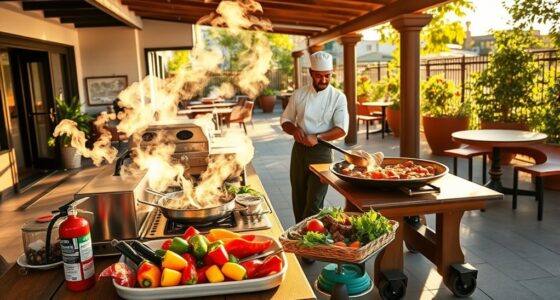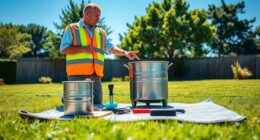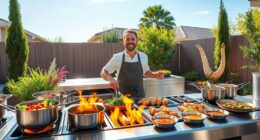To plan a safe multi-course outdoor meal, first assess your space for hazards, ensuring enough room for each station and equipment. Organize your workflow so ingredients are prepped and cooked in sequence, with raw and cooked foods separated to prevent cross-contamination. Keep fire safety in mind by having extinguishers on hand and maintaining safe distances from flames. For detailed safety tips and step-by-step guidance, continue exploring how to create a smooth, hazard-free outdoor cooking experience.
Key Takeaways
- Design a clear workflow that sequences prep, cooking, and serving to minimize cross-contamination and unnecessary movement.
- Ensure all heat sources are safely located, well-maintained, and equipped with accessible fire extinguishers.
- Allocate separate zones and tools for raw and cooked foods to prevent cross-contamination.
- Organize storage to keep perishables chilled and protected from environmental hazards.
- Assign specific tasks to team members and stagger cooking times to avoid overcrowding and ensure safety.
Assessing Your Outdoor Cooking Space and Equipment
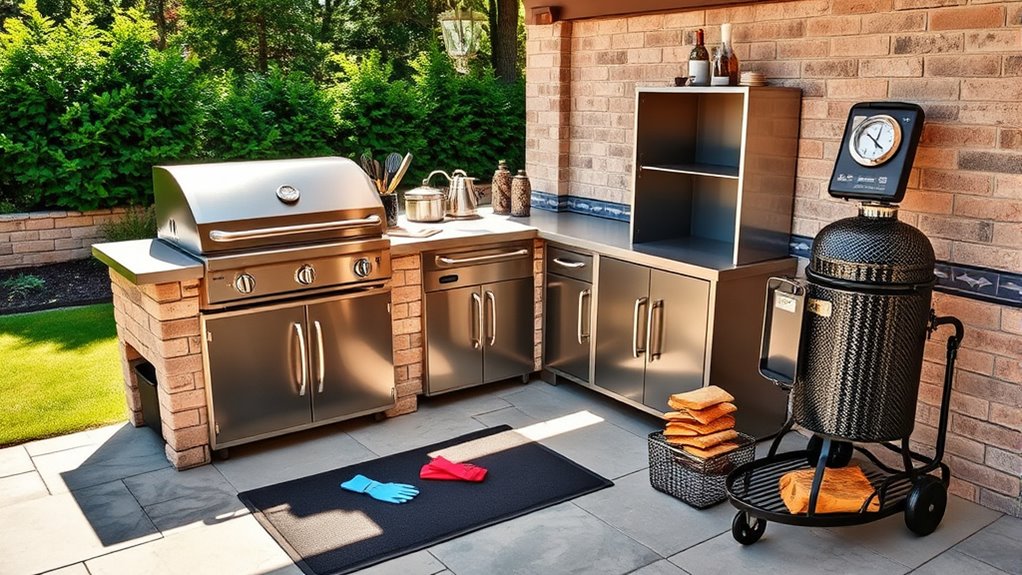
Before you start planning your outdoor cooking flow, it’s essential to assess your space and equipment. Take a close look at your available area, noting any potential hazards or obstacles. Consider storage solutions to keep utensils, tools, and ingredients organized and easily accessible. Evaluate your equipment’s condition and functionality, ensuring everything is safe to use. Weather considerations are vital—identify shaded areas or windbreaks to protect your setup from rain, wind, or excessive sun. Think about how much space each cooking station will need and whether your current layout allows for smooth movement. Proper assessment helps you create an efficient workflow, minimizes safety risks, and makes your outdoor cooking experience more enjoyable and stress-free.
Designing a Safe and Efficient Cooking Workflow
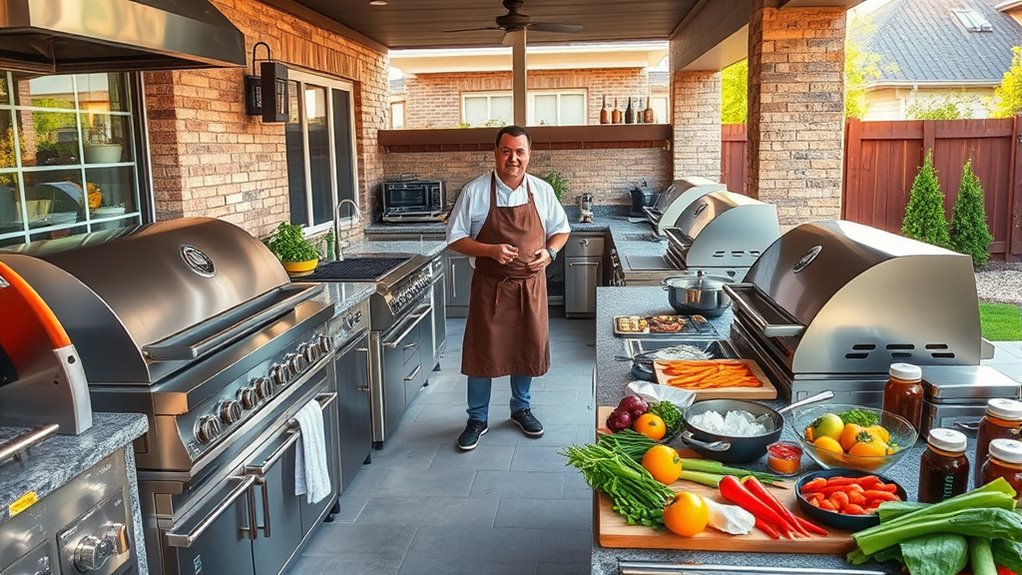
Once you’ve assessed your space and equipment, the next step is to design a cooking workflow that maximizes safety and efficiency. Start by organizing food storage areas away from heat sources and walkways to prevent cross-contamination. Plan your steps logically: prep ingredients first, then cook, followed by plating and serving. Incorporate streamlined cleanup procedures, placing trash and compost bins nearby to encourage quick disposal. Keep raw and cooked foods separated, and ensure utensils and surfaces are cleaned regularly to avoid contamination. Map out your process to minimize unnecessary movement, reducing risks of accidents. Regularly inspecting your skincare patches can help ensure proper adhesion and effectiveness during use. A well-structured workflow keeps you focused, saves time, and maintains safety throughout the outdoor cooking experience.
Handling and Preparing Ingredients Safely
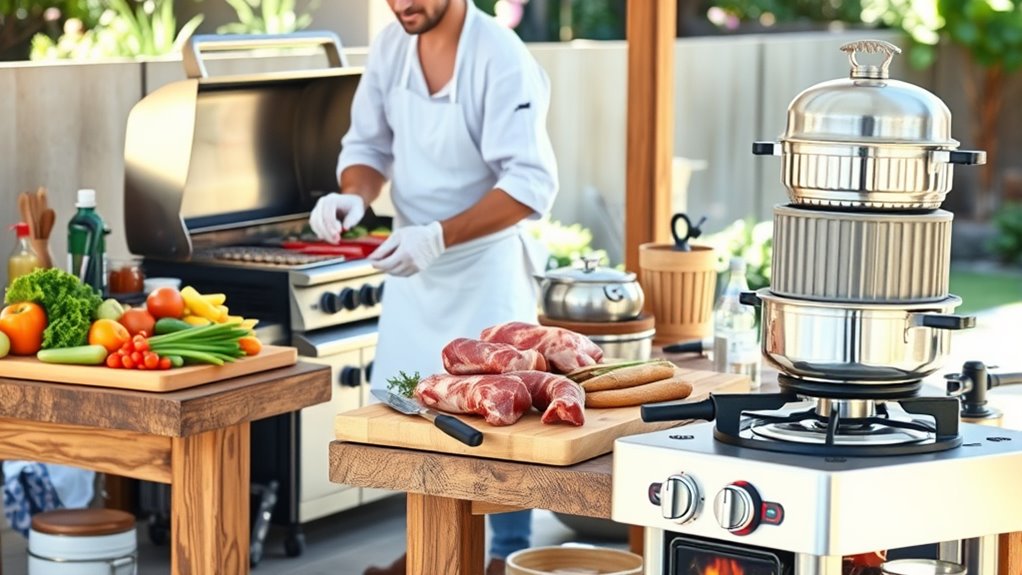
Handling and preparing ingredients safely is vital to prevent foodborne illnesses and guarantee a smooth outdoor cooking experience. You must prioritize proper food storage to keep ingredients fresh and avoid cross-contamination. Maintaining good personal hygiene is essential; always wash your hands thoroughly before handling food and after touching raw ingredients or surfaces. Use separate cutting boards for raw meats and vegetables to prevent cross-contact. Keep perishable items chilled until ready to cook, and cover ingredients to protect them from dirt and insects. Proper food storage and personal hygiene are the foundation of safe outdoor food preparation. Freshness preservation techniques are also important to maintain ingredient quality and safety during outdoor cooking.
Managing Heat Sources and Fire Safety Measures
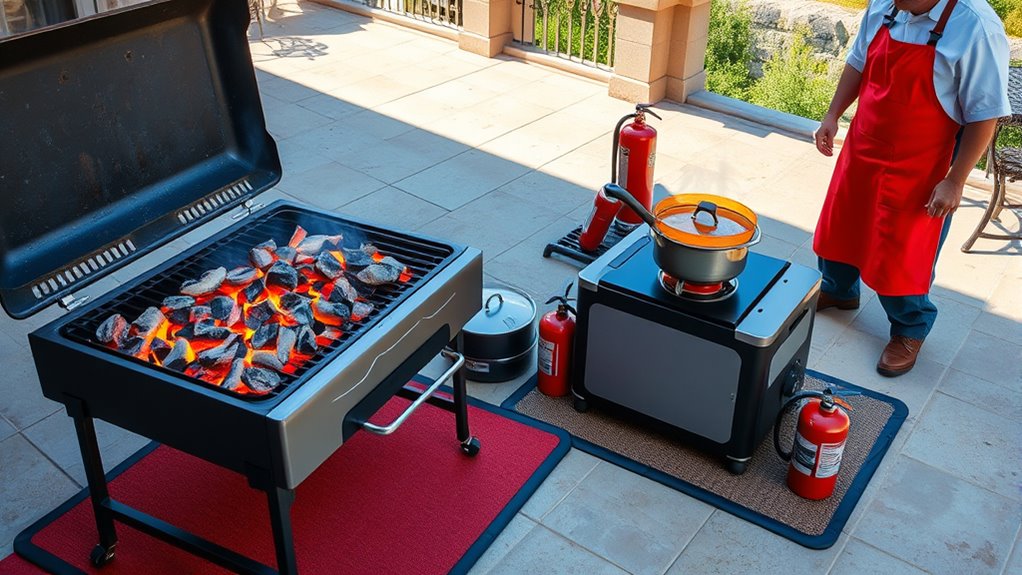
Effective management of heat sources and fire safety measures is vital to guarantee a safe and successful outdoor cooking experience. Always keep a fire extinguisher nearby, and make certain you know how to use it properly in case of emergencies. Use heat insulation materials around grills and open flames to prevent accidental fires and protect surfaces from heat damage. Be mindful of your heat sources, maintaining a safe distance from combustible materials, and avoid overcrowding your cooking area. Regularly check equipment for leaks or damage, and never leave active flames unattended. Clear the area of dry leaves, paper, or other flammable debris that could ignite unexpectedly. Implementing proper fire safety practices and understanding fire risks can significantly reduce the chances of accidents. By staying vigilant and prepared, you minimize fire risks and create a safer outdoor cooking environment for everyone involved.
Coordinating Multiple Dishes Without Compromising Safety
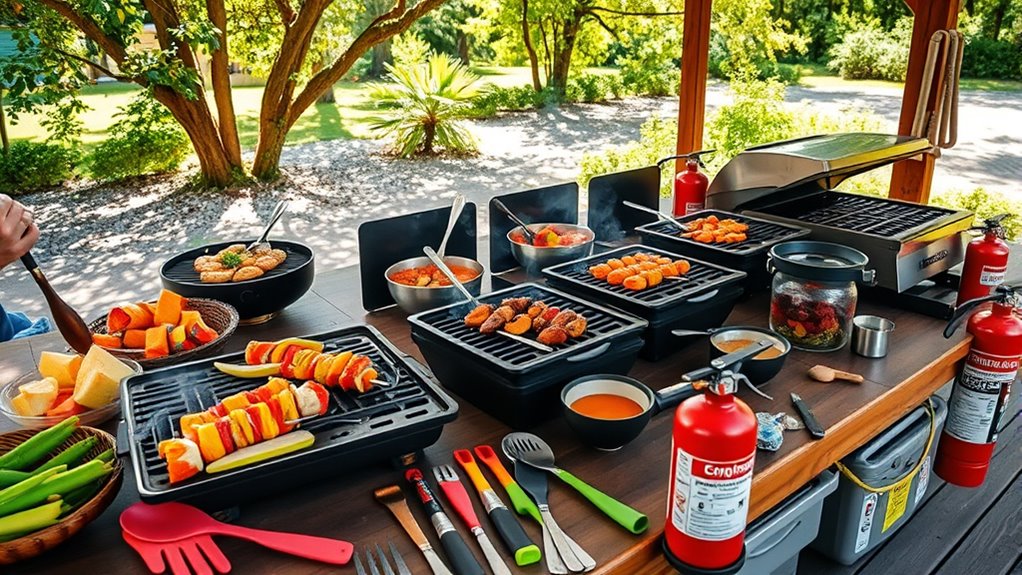
Coordinating multiple dishes during outdoor cooking requires careful planning to guarantee safety and efficiency. You need to manage cooking timing and ingredient prep to prevent cross-contamination and accidents. To stay organized, consider:
Effective outdoor cooking relies on careful planning and organization for safety and success.
- Staggering cooking times to avoid overcrowding the grill or stove
- Preparing ingredients in advance for quick assembly
- Assigning specific tasks to each person to streamline workflow
- Keeping raw and cooked foods separate to prevent contamination
- Ensuring proper food safety practices are followed throughout the process.
Frequently Asked Questions
What Are the Best Practices for Cleaning Outdoor Cooking Equipment?
You should regularly clean your outdoor cooking equipment by using proper cleaning techniques like scrubbing grills with a brush and cleaning surfaces with warm, soapy water. Always maintain your equipment by inspecting for rust or damage and performing necessary repairs. After each use, wipe down surfaces, remove grease, and store equipment properly. Consistent cleaning and maintenance guarantee safety, prolong equipment life, and keep your outdoor cooking enjoyable and hygienic.
How Can I Prevent Cross-Contamination Between Raw and Cooked Foods?
To prevent cross-contamination, always keep raw and cooked foods separate by storing raw items in sealed containers away from cooked foods. Use different utensils for raw and cooked foods, and don’t reuse utensils without washing them thoroughly in between. Practice proper food storage, ensuring raw meats stay below cooked foods in the cooler, and wash your hands frequently. These steps help keep your outdoor cooking safe and contamination-free.
What Safety Gear Should I Wear During Outdoor Cooking?
You should wear protective clothing like long sleeves and an apron to shield your skin from splatters and burns. Heat-resistant gloves are essential for handling hot pots, grills, or coals safely. Consider wearing a hat or visor to protect your face from the sun, and use sunglasses for eye protection. Always verify your gear is clean and in good condition to prevent accidents and stay safe during outdoor cooking.
How Do I Handle Accidental Fires or Flare-Ups?
If a fire or flare-up happens, stay calm and act quickly. Use fire suppression techniques like smothering the flames with a metal lid or damp cloth. Keep a fire extinguisher nearby, and never try to move the grill. Prevent flare-ups by trimming excess fat and avoiding overcrowding. Remember, quick response and proper flare-up prevention keep everyone safe and your outdoor cooking enjoyable.
What Are the Legal Regulations for Outdoor Cooking in Public Spaces?
You need to check local laws for outdoor cooking in public spaces, as permitting requirements vary. Always follow fire safety regulations to prevent accidents, such as keeping a fire extinguisher nearby and avoiding flammable materials. Some areas may require permits or restrict certain equipment. It’s your responsibility to stay informed and adhere to these regulations to ensure safety and avoid fines or legal issues while enjoying outdoor cooking.
Conclusion
By following these tips, you’ll master outdoor cooking with the precision of a Flash Gordon hero. Always assess your space, handle ingredients with care, and manage heat sources responsibly. Keep safety top of mind, especially when juggling multiple dishes—think of it as your own quest for culinary greatness. With a little planning and vigilance, you’ll turn your outdoor kitchen into a safe, efficient haven, even if it feels like you’re battling a dragon of chaos.
